
After plummeting during the pandemic, the wellness tourism market has made an extraordinary recovery. According to the Global Wellness Institute’s (GWI) latest Global Wellness Economy Monitor, annual spending growth increased 36% between 2020 to 2022, while the number of annual wellness trips grew by 30% – significantly higher than growth rates for overall tourism trips and expenditures.
In 2022 almost one in five total travel dollars went on wellness trips, and in the next five years, the market is forecast to more than double, with dramatic spending jumps from 2022 ($651bn) to 2023 ($868bn) to 2024 ($1trn). The speed of the industry’s bounce-back from Covid surprised even the GWI, exceeding its expectations and forecasts.
“If the pandemic disrupted industry momentum in the short term, it has simultaneously created a dramatic shift in the long-term opportunities and trajectory for wellness,” said Katherine Johnston, GWI senior research fellow, on the report’s release at the end of 2023. The cruise industry is a case in point, according to Julanda Marais, senior lead of spa and wellness at luxury cruise line Explora Journeys, who has also worked for luxury hospitality companies including Four Seasons Hotels and Resorts and Jumeirah Hotels. “In recent years, there has been a significant shift in cruise guests’ preferences, with a growing demand for wellnessfocused experiences, reflecting a broader societal emphasis on health and well-being,” she says.
She has seen a growing number of guests seeking opportunities to maintain or enhance their wellness routines while on holiday, with a specific focus on fitness activities, healthy dining options, mindfulness and meditation. “With a continued focus on quality of health and emphasis on wellness in travel, it’s much more than a fad, it’s permanently changed how people think about travel,” she believes.
James Cole, founder and managing director of UK-based cruise agency Panache Cruises, agrees. Postpandemic, his team is receiving more wellness-related questions about specific elements of each cruise product. “People are asking if the food ingredients are organic, whether the drinking water on board is energised or how air on board the ship is filtered. Sleep quality is also really important for our customers,” he notes. “Most people assume that wellness at sea is focused just on spa treatments and healthy eating. I would argue that ‘wellness’ embodies far more than this. Within the luxury and ultra-luxury sectors of the cruise industry, wellness now touches on every aspect of the holiday, from the moment someone leaves their home to the moment they return.”
Wellness cruises
Cruise operators are responding in force to guests’ increasing focus on wellness, even beyond the luxury segment. This year, Virgin Voyages themed January to March as speciality ‘Well-being Months’, upping the health offering on their ships with spa-focused programming, wellness workshops and classes, and healthier menus. In spring 2024 P&O Cruises launched specific ‘Well-being and Lifestyle’ cruises with TV presenter and women’s health advocate Cherry Healey and stylist and fashion TV presenter Kat Farmer. The three cruises, which go to Spain, Portugal and the Mediterranean, focus on mind, body sleep and other lifestyle advice, with workshop topics ranging from mind and body to skincare, stillness and meditation. According to P&O, they have proved to be very popular with guests who have appreciated the down-to-earth style of the presenters and the easy-to-follow, straightforward advice for well-being, nutrition and lifestyle.
But it’s Swan Hellenic that has perhaps taken this idea the furthest with its new series of well-being cruises developed with spiritual teacher and author Deepak Chopra. Guests can choose between six ‘Explore & Restore’ wellness cruises in 2024, with on-board Ayurvedic culinary offerings and a Chopracertified meditation and yoga teacher offering private and group sessions every day.
Beyond wellness programmes
For Cole, most innovation is being seen where cruise lines go beyond wellness initiatives and tailor every aspect of the holiday to help people achieve their personal wellness goals. Oceania, for example, offers its Aquamar Spa and Vitality Centre, including complimentary fitness classes and a high-tech fitness centre, but it is also retrofitting its fleet with its new AquaMar Kitchen concept, a restaurant that brings wellness into the kitchen with dishes including poke bowls, healthy burgers and a wide range of smoothies and salads. Speaking to Travel Weekly, the brand’s president, Frank A Del Rio, said he expects a younger crowd, perhaps millennials, who have a “hyperfocus” on wellness, to most appreciate the new venue. “I’m not so in love with health-oriented food, but that’s just me,” he said. “I’m an eater; I like greasy food. But it bodes well with our approach to this new wellnessoriented traveller.”

Meanwhile, on Celebrity Cruises, guests in Aqua Class receive an overall wellness experience with access to the on-board spa areas, a complimentary wellness consultation, and exclusive access to the Blu restaurant, which offers ‘cleaner’ cuisine. At Explora Journeys, Explora I, which launched last summer and is the first of six luxury ships, offers over 700m2 of wellness facilities focused on the brand’s ‘Ocean Wellness’ offering. Experiences, programmes and spaces have all been designed to enhance the ocean’s influence on well- being. The concept of well-being is even reflected in the suite design, where guests can also access meditation and workout videos on the in-suite TVs. Wellness options range from Morning Salutation Awakening Yoga Flow to collaborations with spa and wellness brands that provide tailored experiences.
“This evolution towards a more wellness-focused luxury ocean travel experience is not just about physical health; it encompasses a holistic approach that includes mental, emotional and sometimes even spiritual well-being,” Marais says.
The new central aspect of the luxury cruise sector
But what about the all-you-can-eat buffets and the free-flowing drinks? For Marais, one of the primary challenges the industry is facing at present is balancing the introduction of new wellness features and healthier options with the preservation of more traditional elements of the cruise experience, such as indulgent dining and entertainment.
At present, she says, the key is to offer guests a choice. And this applies from the layout of ships to the experiences on offer. “We designed our ships with wellness in mind from the outset, allowing for dedicated spaces that do not detract from other amenities,” she notes. “We are also curating wellness experiences that can be personalised for guests, ensuring that they cater to individual needs and preferences.”
Training Explora’s hosts to become wellness ambassadors and equipping them with the knowledge to guide guests through the available options is another strategy that has proved effective for the brand.
Cole, however, believes the indulgence of previous years may soon be a thing of the past, at least in the luxury cruise sector. “A lot of operators in the wider travel sector have traditionally focused on excess; the typical all-inclusive holiday was never designed to keep people well,” he says. “However, this is changing fast, and it is the luxury and ultra-luxury sectors within travel that are driving this change.
“The luxury and ultra-luxury cruise sectors are focused on customer service first and foremost. People are paying for a bespoke experience. As such, the product is already adept at changing itself to meet people’s needs. What is happening here is that people’s needs are changing. I would argue that wellness is now the central aspect of the luxury cruise sector.”
Supporting the well-being of guests and crew
From walking tracks to yoga decks to poke bowls to meditation sessions, wellness-focused offers are becoming part and parcel of the cruise experience. And according to Marais, the trend is only going one way. “There is a growing emphasis on creating an environment that supports the well-being of both guests and crew, with initiatives such as e-learning platforms for wellness education and coaching programmes designed to promote health and well-being on board,” she notes.
The GWI is working to help tourism businesses implement strategies such as this with its Wellness Policy Toolkit. It’s not about developing luxury spas or bringing in high-spend tourists, the organisation says, but exploring how tourism can support the wellness of travellers, destinations and even local residents – from supporting workforce development to the use of technology to enhance wellness for travellers.

Marais also believes technology is poised to play a bigger role in the wellness space at sea. “We expect even more personalised and tech-integrated solutions, such as wearable devices that track health metrics and virtual reality experiences that enhance mindfulness practices,” she predicts. “The industry is likely to continue innovating to meet the rising demand for wellness-oriented travel.”
We’ll see you on the yoga mat.






